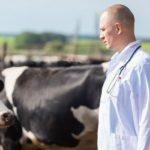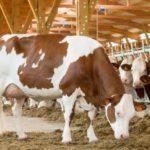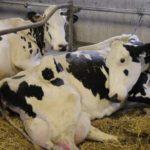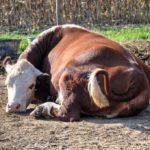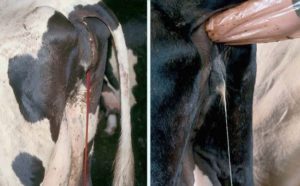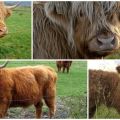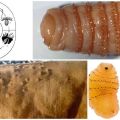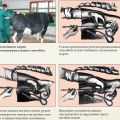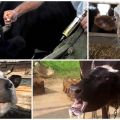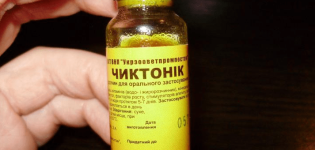Causes and symptoms of trichomoniasis in cattle, treatment and is it dangerous for humans
Trichomoniasis is a dangerous disease caused by the simplest microorganisms, rapidly multiplying and tenacious. With trichomoniasis in cattle, inflammatory reactions and tissue destruction occur in the body under the influence of the waste products of parasites. The disease affects the genitals of animals of both sexes, which negatively affects reproductive function. In the absence of treatment, cows are terminated pregnancy, bulls become infertile.
The history of the development of trichomoniasis
The causative agent of the disease - the simplest microorganism Trichomonas fetus - was identified in 1888 in the vagina of a cow. Trichomonas, which reproduce by simple cell division, affect cattle on all continents.
The intermediate living environment of primitive parasites:
- water sources;
- insect feces;
- blood-sucking insects;
- feces of warm-blooded animals;
- rotten bedding in the stable;
- urine;
- non-sterile veterinary devices;
- livestock equipment that is not disinfected.
The main habitat of Trichomonas is the genitals of livestock. The vaginal epithelium of the cow contains starch, in the urethral canal, prostate gland and testes of bulls there is a nutrient-rich secret - these are sources of nutrition for pathogenic microorganisms. Trichomonas also feed on bovine sperm.
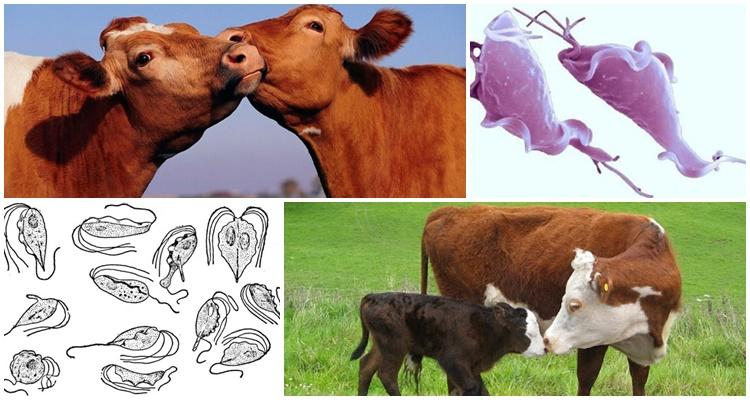
Causes and symptoms of the disease
Trichomonas are equipped with movable flagella, with the help of which they move along the vagina and urethral canal, fixing on the mucous membranes. Bulls and cows are equally likely to have trichomoniasis, and even calves can be infected asexually. Unicellular parasites are active and tenacious. Outside the host's body, they remain viable for up to a month, being protected from negative external factors by a dense membrane, and in the genital organs of cattle they live up to 2 years.
Infection of cattle is possible both with natural mating and with artificial insemination, but in the first case, the risk is much higher. In artificial insemination, the instruments are disinfected, and the semen is laboratory-checked for infection. Therefore, infection with trichomoniasis is possible only if the rules of hygiene and disinfection are ignored.
When a cow is infected from a bull, Trichomonas begin to multiply intensively on the external genital organs, then penetrate inside. Reproduction is so fast that an inflammatory reaction occurs the next day, and the first symptoms are observed after a few hours.
In rare cases, the incubation period lasts up to 2-3 weeks. The rate of development of trichomoniasis is determined by the immunity, sex and age of the animal. The diagnosis is made by a veterinarian after a laboratory test, but the owner himself can understand that his cow is sick with trichomoniasis, according to the following symptoms:
- restless animal behavior;
- frequent looking at the back of the body;
- feeling unwell;
- lack of appetite;
- swelling of the external genital organs;
- inflammation of the mucous membranes of the vagina (after about 2 days);
- pinpoint rashes on the vaginal walls;
- small nodes on the mucous surface of the genital tract;
- mucous and flocculent vaginal discharge (after about 2 weeks).
If untreated, the cyclical functioning of the reproductive organs is disrupted. The cow develops purulent-catarrhal endometritis - an acute inflammation of the mucous membranes of the uterus.
When the parasites enter the cow's vagina with infected bull sperm, trichomoniasis develops in parallel with uterine development of the calf.
A miscarriage usually occurs in the 2-4th month of gestation, followed by inflammation of the uterus and ovaries. The cow becomes sterile. Sometimes the embryo is not aborted, but, having died, begins to rot in the mother's womb, carrying a mortal danger to the life of the cow.

Diagnostic measures
If at least one cow with trichomoniasis is found, the farmer must immediately quarantine. It is forbidden to bring new animals to the farm, to take out livestock. All animals on the farm are carefully examined, each individual is taken for analysis:
- In non-pregnant females, vaginal discharge. 2-3 days after infection, the maximum concentration of pathogenic microorganisms is detected in the vaginal mucus.
- In cows that have suffered a miscarriage, the fetus is dead. Abdominal and retrosternal tissues are collected for analysis.
- In bulls - semen and mucous discharge from the urethral canal.
The collected biomaterial is placed in saline and examined under a microscope. It is advisable to conduct a laboratory test 2 times with an interval of 10 days. This will not only allow to accurately identify sick animals, but also prevent complications due to concomitant pathologies. Cow gonorrhea caused by Trichomonas is symptomatically little different from other infectious diseases: chlamydia, toxoplasmosis. Therefore, laboratory analysis is indispensable.
Treatment of trichomoniasis in cattle
Infected livestock are kept separate from healthy animals. The stables are regularly and thoroughly treated with disinfectants (sodium hydroxide, soda ash, lime). Treat trichomoniasis in cattle in a complex way. First of all, sick cows are treated with procedures aimed at cleansing the genital tract from accumulated infection. For this, medications are used that cause contraction of the walls of the uterus:
- "Oxytocin";
- "Proserin";
- "Pituitrin".
The vagina is washed with a 10% ichthyol solution with the addition of glycerin, iodine-saline solution, "Furacilin" or another nitrofuran preparation. For douching, the solution is heated to 38-40 ° C. To treat the vagina of one cow, 0.5 liters of treatment fluid is required.
One subcutaneous injection of the drug "Metronidazole" is made every day for 5 days. For 100 kg of body weight, cows take 5 g of the substance. Diluted with saline or novocaine. If, after a course of injections, the analysis for trichomoniasis remains positive, then the therapy is continued.

To kill the pathogenic microflora, cattle of both sexes are given antibiotics. Suitable drugs "Trichopol", "Trichomonacid". Bulls are additionally treated with external antiseptics, the genitals are treated with a solution of the drug "Furazolidone", then an antiseptic ointment is applied.
If a cow has a strong immune system, then she suffers mild trichomoniasis, recovers without drug therapy, and sometimes does not get sick at all. But such cases are rare.
Preventive actions
There is no vaccine against trichomoniasis, so it is impossible to protect cattle from infection. But there is an opportunity to diagnose an infectious disease in a timely manner, to prevent its spread, to create conditions that reduce the likelihood of an infection. Main preventive measures:
- Any livestock brought into the farm is quarantined for about a month. Each animal is tested for trichomoniasis. After receiving the results of the analysis, indicating that the cattle are not infected, the brought animals are moved to the rest of the herd.
- You should buy cattle only in safe, proven farms, where the sanitary situation is not satisfactory.
- If there are suspicious symptoms even in one individual, all livestock, from six-month-old calves to elderly individuals, are examined for infectious lesions. It is unacceptable to lift quarantine, to resume the usual keeping of livestock until a negative test result comes from the veterinary laboratory.
- The main way to prevent trichomoniasis in cattle is to periodically check bovine semen for parasites. Bulls that have undergone the disease, participating in the fertilization of cows, are checked for trichomoniasis within the next 2 months at 10-day intervals.
- Cattle stock is periodically disinfected in any convenient way. The bedding in the stalls is timely replaced.
- Instruments for artificial insemination of livestock before the procedure are carefully sterilized according to the instructions. The seed taken from the bull is checked for infection.
- Cattle on free grazing are not allowed to come into contact with animals brought to pasture from other farms.
Danger to humans
Trichomoniasis in cattle is not transmitted to humans. The disease is one, but different pathogens belonging to the genus Trichomonas cause it in cows and humans:
- human parasite - Trichomonas vaginalis (Trichomonas vaginalis);
- cattle parasite - Trichomonas fetus (Trichomonas foetus).
Therefore, the farmer may not be afraid that he will become infected with trichomoniasis by contact with sick cattle. But it is impossible to forget about the hygiene rules, since unkempt animals can pick up another infection that is dangerous to humans.
A person will not get sick with trichomoniasis, even by eating contaminated milk and meat. But after the slaughter of livestock carcasses, a veterinarian examines for the presence of purulent vaginal mass and endometritis. If these diagnoses are confirmed, then the inflamed and pus-filled organs must be removed and disposed of.
If a cow has a purulent vaginal discharge, the farmer should immediately call a veterinarian. If the diagnostic measures confirm trichomoniasis, then the treatment cannot be delayed, otherwise the disease will cause significant material damage to the farm.






